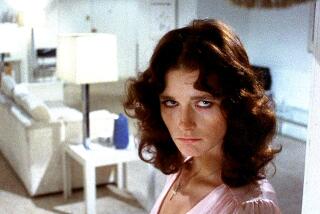Final Credits for La Jolla Film Curator
- Share via
LA JOLLA — “Curse of the Demon,” a low-budget horror flick produced in 1958, features Dana Andrews battling “the demons of hell,” which look like cheap forerunners of the characters created for “Gremlins.” It was directed with chilling calculation by Jacques Tourneur, the same master of B-movie horror films who produced such campy classics as “I Walked With a Zombie.”
Although some may chuckle at the special effects, “Curse of the Demon” is an extremely fitting lead-off film to the San Diego Museum of Contemporary Art’s three-month-long “Parting Glances” series, primarily because the museum’s film curator, Gregory Kahn, loves it.
For 14 years, Kahn has been the museum’s film curator, and throughout that period the programs have been a reflection of his far-ranging tastes.
“Parting Glances” will spotlight 12 of Kahn’s favorites from the programs presented at the museum during his tenure, ranging from Ernst Lubitsch’s 1932 classic, “Trouble in Paradise” (which will screen Feb. 12) to the fast-paced 1971 hit “Walkabout” (Jan. 22) by Nicolas Roeg, whose quick-cut, hip style Kahn views as a predecessor to today’s music videos.
As the title suggests, “Parting Glances” is something of a last hurrah for Kahn.
The museum will lay him off when the series ends in March, and the film program will be suspended “in anticipation of the closing of Sherwood Auditorium for renovations and refurbishing,” according to the museum’s newsletter.
Like many art institutions around the country, the museum is cutting back in several areas. The multimillion-dollar renovation is not scheduled to begin until the fall at the earliest, and, according to a museum spokesman, the film program lost $20,000 last year. That is roughly equivalent to the cost of one new palm tree in the $10.5-million renovation plan and, considering the exposure the program has offered the museum, some have speculated that there is more happening behind the scenes than a simple desire to put the film program on hiatus. Kahn believes that the program may be reinstated in the future, but without a specialized curator to run it.
Museum Director Hugh Davies said no definite plans have been made, but acknowledged that the program may be revived in 1994, sans curator. The position may be combined with another, or the economic climate may change dramatically and allow for a full-time curator, he said.
Davies also said that attendance of the film series has dropped from 10,000 a year three years ago to less than 6,000 in the past year. The suspension of the series will open up the possibility of renting out Sherwood Auditorium more often to outside groups, he said.
But more than anything, Davies said, the decision to suspend the program was based on the fact that the series was scheduled to go on hiatus during the renovation regardless of the museum’s economic situation.
“To me, it seemed logical, since we knew we were going to have to cut anyway, to cut sooner rather than later,” Davies said, noting that a similar rationale was used when the museum decided to wait several months before hiring a replacement for the education curator, who resigned to take another job a few months ago.
The big loser in the demise of the current film program--other than Kahn--will be the San Diego film community, which will lose, at least temporarily, the only regular venue spotlighting truly obscure art and foreign films. Although certain festivals and the local art theaters occasionally feature the work of uncelebrated and non-mainstream filmmakers, none displays Kahn’s gleeful willingness to focus on the rare and offbeat.
The museum’s films always unabashedly reflected Kahn’s personal tastes and interests.
“Any museum program should be a reflection of the curator,” Kahn said. “The programs become a dialogue between the curator and the community.”
“Parting Glances” is a fitting example of Kahn’s eclectic interests. While some critics and fans are captured by great acting performances or great scripts, Kahn tends to focus on the images and “atmosphere” created by the director, the auteur.
“To me, the director is the painter, he is the artist,” said Kahn, who also notes that “atmosphere is an underappreciated aspect of the filmmaking experience.” So-called good acting can often ruin a film, he says, detracting from the essence of the art form. He deplores homogeneous directors.
“Curse of the Demon,” which screens today at 7:30 p.m., is a fairly typical example of Kahn’s often whimsical interests. He looks beyond the special effects to see Tourneur’s innovative use of light and shadow, his ability to create mood and an edgy atmosphere simply by his composition and smooth editing.
Kahn can enjoy the crash-and-burn fun of James Cameron’s “Terminator 2,” but he views “Curse of the Demon” as art, a classic and seminal horror film and an example of a director creating something special despite a low budget.
“The man had ideas about art, and that’s what’s exciting,” Kahn said. “Cameron has no ideas about art, except he works in an art form, and that should bother some people.”
Some of the films in the series are hardly surprising. Francois Truffaut’s “The 400 Blows” (Jan. 29), a seminal statement in the French new wave movement, and Ingmar Bergman’s classic “Wild Strawberries” (March 25) would make the favorites list of many cinephiles.
Kahn has also included the seemingly obligatory film from Akira Kurosawa, although “Dersu Uzala” (Feb. 26) is one of the Japanese artist’s lesser-known classics.
“I could have shown ‘Rashomon’ or ‘Seven Samurai,’ but you really can’t see ‘Dersu Uzala,’ so that whetted my appetite,” Kahn said.
Other selections are far less predictable.
“The Driver” (March 11) is often described as the car chase movie to end all car chase movies. The action pits a stoic getaway driver (Ryan O’Neal) against a gung-ho cop (Bruce Dern at his smarmiest) who vows to bring him in. “The Driver,” directed in 1978 by Walter Hill, is a modern version of a classic Western. The dialogue is sparse. The characters, none of whom have names, are mysterious, with unknown pasts and seemingly mono-dimensional lives.
“One of the things Walter Hill is interested in--and this film underscores it best--is the lone man who lives by a code in the midst of a society crumbling around him,” said Kahn, an unabashed admirer of John Ford Westerns and the similarly heroic samurai films from Japan.
Yet it’s not a film that many would consider a classic. However, to Kahn, there is beauty in the simplicity.
“The attention paid to every detail is so economical,” he said. “Everything fits together.”
Though most of the films have little relation to each other, beyond Kahn’s appreciation, “The Driver” is a direct descendant of “Le Samourai,” Jean-Pierre Melville’s 1967 moody gangster film, which will screen the week before “The Driver,” on March 4. Kahn said he was inspired by an art curator he admires who believes in “creating dialogue” between different pieces.
“He looks at pieces as part of the experience, what else is hung in the gallery,” Kahn said. “In that vein, I wanted to show ‘Le Samourai’ and ‘The Driver’ back-to-back.”
It is also no accident that Kahn has chosen “Wild Strawberries” to close the series. It is the story of a professional man forced to reflect and re-evaluate his life.
In some ways, Kahn is in a similar situation. He will continue to teach part time at San Diego State University, but otherwise his future is up in the air. Museum film curator jobs are rare, and there are few opportunities for someone like Kahn to utilize his expansive knowledge and love of film.
“Maybe I’ll stand on a corner with a sign that says, ‘Will show films for food,’ ” he joked.
“Parting Glances” continues every Wednesday night through March 25. Screenings begin at 7:30 each night at the San Diego Museum of Contemporary Art’s Sherwood Auditorium, 700 Prospect St., La Jolla. Tickets are $3 for museum members, $4 for non-members. Call 454-3541 for more information.
More to Read
The biggest entertainment stories
Get our big stories about Hollywood, film, television, music, arts, culture and more right in your inbox as soon as they publish.
You may occasionally receive promotional content from the Los Angeles Times.










